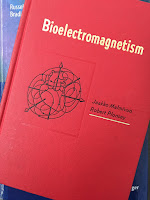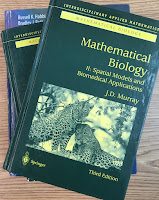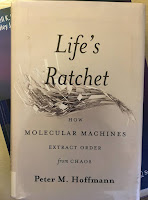In the October 2012
issue of the
American Journal of Physics,
Dawn Meredith and
Jessica Bolker published an article about “
Rounding Off the Cow: Challenges and Successes in an Interdisciplinary Physics Course for Life Science Students” (Volume 80, Pages 913–922). The article is interesting, and much of the motivation for their work is nearly identical to that of
Russ Hobbie and I in writing the 4th edition of
Intermediate Physics for Medicine and Biology. They focus on an introductory physics class, whereas Russ and I wrote an intermediate level textbook. Nevertheless, many of the ideas and challenges are the same. Here, I want to focus on their Table 1, in which they list topics that are emphasized and deemphasized compared to standard introductory classes.
Table I. Changes in topic emphasis compared to standard course
| Semester 1 | Semester 2 |
|---|
| Included/stressed | Kinematics | Heat transfer |
|---|
| Dynamics | Kinetic theory of gases |
|---|
| Static torque | Entropy |
|---|
| Energy | Diffusion, convection, conduction |
|---|
| Stress/strain and fracture | Simple harmonic motion |
|---|
| Fluids (far more) | Waves (sound, optics) |
|---|
| Omitted/de-emphasized | Projectile motion | Heat engines |
|---|
| Relative motion | Magnetism (less) |
|---|
| Rotational motion | Induction (qualitatively) |
|---|
| Statics | Atomic physics (instrumentation) |
|---|
| Collisions | Relativity |
|---|
| Newton’s law of gravitation | |
|---|
| Kepler’s laws | |
|---|
How does this list compare with the content of
IPMB? We don’t stress kinematics and dynamics much. In fact, most of our mechanics discussion centers on
static equilibrium.
Interestingly, Meredith and Bolker emphasize
static torque, which is absolutely central to our analysis of
biomechanics in Chapter 1. Rotational equilibrium and torque is what explains why bones, muscles and tendons often experience forces far larger than the weight of the body. It also underlies our rather extensive discussion of the role of a cane. We discuss mechanical energy in Chapter 1, but
energy doesn’t become an essential topic until our Chapter 3 on
thermodynamics. We agree completely with Meredith and Bolker’s listing of “stress/strain and fracture” and “Fluids (far more)”, and I second the “far more”. Our Chapter 1 contains a lot of
fluid dynamics, including the biologically-important concept of
buoyancy, the idea of high and low
Reynolds number, and applications of fluid dynamics to the
circulatory system.
The time allotted to an introductory physics class is limited, so something must get deemphasized to free up time for topics like fluids. Meredith and Bolker mention
projectile motion (we agree, it is nowhere in
IPMB), relative motion (not crucial if not covering relativity), and rotational motion (we don’t emphasize this either, except when analyzing the
centrifuge). I don’t really understand the omission of statics, because as I said earlier static mechanical equilibrium is crucial for biomechanics. They deemphasize collisions, and so do we, although we do discuss the collision of an electron with a photon when analyzing
Compton Scattering in Chapter 15.
Newton’s law of gravity and
Kepler’s laws of planetary motion are absent from both our book and their class.
In the second semester, Meredith and Bolker stress
heat transfer (convection and conduction), the
kinetic theory of gases, and
entropy. Russ and I discuss all these topics in our Chapter 3.
Diffusion is a topic they emphasize, and rightly so. It is a topic that is typically absent from an introductory physics class, but is crucial for biology. We discuss it in detail in Chapter 4 of
IPMB. Meredith and Bolker list
simple harmonic motion among the topics they stress. We talk about harmonic motion in Chapter 10, but mainly as a springboard for the study of
nonlinear dynamics. Much of the analysis of linear harmonic motion is found in
IPMB in an appendix. Finally, they stress waves (
sound and
optics). We do too, mainly in our Chapter 13 about sound and
ultrasound; a new chapter in the 4th edition.
Topics they omit or deemphasize in the second semester include
heat engines. We barely mention heat engines at the end of Chapter 3, and the well-known
Carnot heat engine is never analyzed in our book. Meredith and Bolker deemphasize
magnetism and
magnetic induction. As a researcher in
biomagnetism, I would hate to see these topics go. Russ and I analyze biomagnetism in Chapter 8. However, I could see how one might be tempted to deemphasize these topics; biomagnetic fields are very weak and do not play a large role in either biology or medicine. I personally would keep them in, and they remain an important part of
IPMB. They do not stress “Atomic Physics (Instrumentation)” and I am not sure exactly what they mean, especially with their parenthetical comment about instruments. We talk a lot about
atomic physics in Chapter 14 on Atoms and Light. Finally, Meredith and Bolker omit
relativity, and so do Russ and I, except as needed to understand
photons. We never discuss the more traditional phenomena of relativity, such as the
Lorentz contraction,
time dilation, or
simultaneity.
Some topics should get about the same amount of attention as in a traditional class, but with slight changes in emphasis. For instance, I would cover
geometrical optics, including
lenses (when discussing the eye and eyeglasses) but I would skip
mirrors. I would cover
nuclear physics, but I would skip
fission and
fusion, and focus on
radioactive decay, including positron decay (
positron emission tomography).
I think that Meredith and Bolker provide some useful guidance on how to construct an introductory physics class for students interested in the life sciences. Russ and I aim at an intermediate class for students who have taken a traditional introductory class and want to explore applications to biology and medicine in more detail. Our book is clearly at a higher mathematical level: we use
calculus while most introductory physics classes for life science majors are algebra based. But for the most part, we agree with Meredith and Bolker about what physics topics are central for biology majors and pre-med students.







